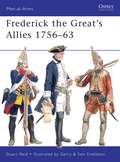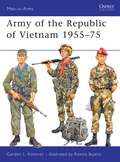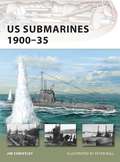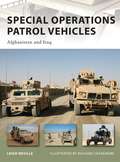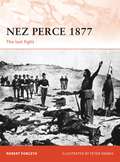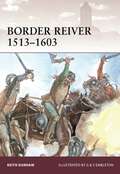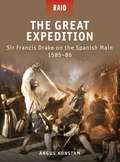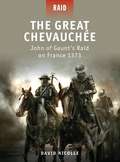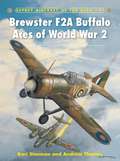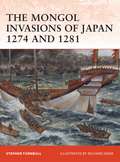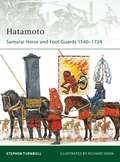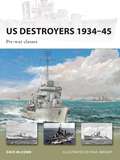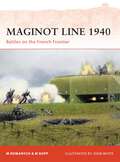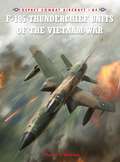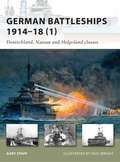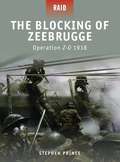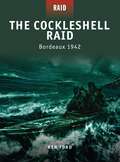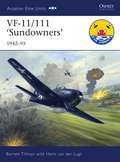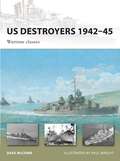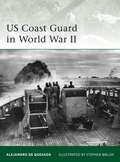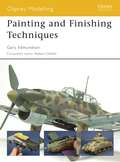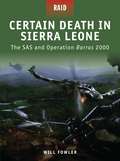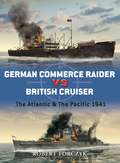- Table View
- List View
Frederick the Great’s Allies 1756–63 (Men-at-Arms)
by Gerry Embleton Stuart Reid Sam EmbletonThe Seven Years' War in Germany was characterised by an increasing use of 'light' troops in conjunction with regular infantry and cavalry as part of an ongoing evolution in military tactics. This book draws attention to these tactical developments and also provides an analysis of the allied army that fought alongside Frederick the Great in Germany. Composed of troops from the electorate of Hanover and contingents from Hessen-Kassel, Brunswick and Prussia, this force was funded by Britain and led by a Prussian officer, Prince Ferdinand of Brunswick. Later, British troops joined this army as it operated throughout western Germany, and together the allied army won a great victory at the famous battle of Minden in 1759.
Army of the Republic of Vietnam 1955–75 (Men-at-Arms)
by Ramiro Bujeiro Gordon L. RottmanEvolved from the colonial units created by the French, this book discusses the original reorganization of these forces into the first national army. Complete with a detailed history of the command structure and orders of battle, the author also sheds light on the little known divisional histories of the army through rare, original source material. Moreover, the author examines in detail the evolution of such key units as armoured forces, ranger commands as well as combat unit organisation. This together with a detailed analysis of the experiences of the typical rank and file soldier as well as officer corps provides a concise and detailed history of an army that is too often neglected or quickly judged.
US Submarines 1900–35 (New Vanguard)
by Jim Christley Peter BullThis book introduces the reader to the early years of US submarine development and operation during the first third of the 20th century. It was in this period of growth and change that the submarine moved from a small vessel of limited range and tactical strength to a far ranging force. It also covers the little-told story of the United State's submarine force during World War I, and the lessons they learned that would be passed on to future generations of submariners.
Special Operations Patrol Vehicles: Afghanistan and Iraq (New Vanguard)
by Leigh Neville Richard ChasemoreThe patrol vehicles used by Special Operations Forces in Afghanistan and Iraq vary quite dramatically between the theatres as well as amongst the Coalition members, and have been developed and upgraded to meet the demands of the deployment. Covering all the major Coalition nations, Leigh Neville continues his look at the elite forces deployed in Operations Enduring Freedom and Iraqi Freedom, with this analysis of their vehicles. Tracing the evolution of the vehicle types, from their historical precedents, through their designs to their operational developments, he discusses their advantages and disadvantages, along with their tactical employment. From the mine-protected vehicles used to counter the IED threat in Iraq, the use of Strykers as armoured raiding platforms by the US Rangers, to the civilian vehicles adapted for military service by both Coalition troops and Private Military Contractors in the regions, this book uses rare in-theatre photographs and colour artwork to show the variety and inventiveness of the patrol vehicles being used in combat today.
Nez Perce 1877: The last fight (Campaign)
by Peter Dennis Robert ForczykWith the wars between the US and the Native Americans drawing to a close, one tribe in Eastern Oregon continued to resist. The Nez Perce, led by the 'Red Napoleon' Chief Joseph, refused to surrender and accept resettlement. Instead, Chief Joseph organized a band of 750 warriors and set off for the Canadian border, pursued by 2,000 US Army troops under Major-General Oliver Howard. The army chased the natives for three months, fighting 13 actions. Finally, just 40 miles from the Canadian border, the Army ran Chief Joseph to the ground, and forced him to surrender after a five-day battle near Bear Paw Mountain.
Border Reiver 1513–1603 (Warrior)
by Gerry Embleton Ian Rotherham Keith DurhamStretching from the North Sea to the Solway Firth, the Border region has a sharply diverse landscape and was a battleground for over 300 years as the English and Scottish monarchs encouraged their subjects to conduct raids across their respective borders. This Warrior title will detail how this narrow strip of land influenced the Borderer's way of life in times of war. Covering every aspect of militant life, from the choice of weapons and armour to the building of fortified houses, this book gives the readers a chance to understand what it must have been like to live life in a late-medieval war zone.
The Great Expedition: Sir Francis Drake on the Spanish Main 1585–86 (Raid)
by Peter Dennis Angus Konstam Brian Delf Alan GillilandIn 1585, the English launched a pre-emptive strike against Spain, by attacking her New World colonies. Led by Sir Francis Drake, in command of 21 ships and 1,800 soldiers, the expedition struck first at the Canary Islands, then attacked the city of Santo Domingo and the treasure port of Cartagena. Frequently outnumbered, Drake's soldiers won an series of spectacular victories and, laden with treasure, sailed home to a hero's welcome.
The Great Chevauchée: John of Gaunt’s Raid on France 1373 (Raid)
by David Nicolle Peter DennisIn 1373, John of Gaunt set off from Calais on a great raid to strike at the heart of France. Driven by the high ideals of chivalry,the raiders left with epic pageantry. However, the reality soon overwhelmed the raiders. Beset on all sides by French ambushes and plagued by disease and starvation, the raiders battled their way through Champagne, east of Paris, into Burgundy, across the Massif Central and finally down into the Dordogne. Unable to attack any major fortifications, John of Gaunt's men plundered the countryside, raiding towns and villages, weakening the French infrastructure. While the military value of the raid is debatable, the English knights who finally made it home were hailed as heroes. This book charts the course of the raid from beginning to end, studying all the battles and skirmishes the raiders fought along the way in this bloody example of chivalric warfare.
Brewster F2A Buffalo Aces of World War 2 (Aircraft of the Aces)
by Chris Davey Kari Stenman Andrew ThomasAlthough designed and built for the US Navy, the F2A fought in only one major US engagement, the battle of Midway, in which F2A pilots managed to shoot down a number of Japanese fighters. Soon replaced by the navy, the F2A was exported to Britain, where it was nicknamed the 'Buffalo' thanks to its stubby appearance. The British sent most of these fighters to the Far East where they were used in the defence of Singapore and Malaya. It was in the Winter War, however, that the F2A truly found a home. Calling the plane simply the Brewster, the Finnish flew it against the invading Russians. Overall 37 Finns achieved ace status flying the Brewster, and it was the Finnish fighter of choice until succeeded by the Bf 109 in 1943.
The Mongol Invasions of Japan 1274 and 1281 (Campaign #217)
by Stephen Turnbull Richard HookFrom his seat in Xanadu, the great Mongol Emperor of China, Kubla Khan, had long plotted an invasion of Japan. However, it was only with the acquisition of Korea, that the Khan gained the maritime resources necessary for such a major amphibious operation. Written by expert Stephen Turnbull, this book tells the story of the two Mongol invasions of Japan against the noble Samurai. Using detailed maps, illustrations, and newly commissioned artwork, Turnbull charts the history of these great campaigns, which included numerous bloody raids on the Japanese islands, and ended with the famous kami kaze, the divine wind, that destroyed the Mongol fleet and would live in the Japanese consciousness and shape their military thinking for centuries to come.
Hatamoto: Samurai Horse and Foot Guards 1540–1724 (Elite)
by Stephen Turnbull Richard HookEach great samurai warlord, or daimyo, had a division of troops known as the Hatamoto, 'those who stand under the flag'. The Hatamoto included the personal bodyguards, the senior generals, the standard bearers and colour-guard, the couriers, and the other samurai under the warlord's personal command. Apart from bodyguard and other duties in immediate attendance on the daimyo, both horse and foot guards often played crucial roles in battle. Their intervention could turn defeat into victory, and their collapse meant certain defeat. As favoured warriors under the warlord's eye, members of the bodyguards could hope for promotion, and a few even rose to be daimyo themselves. All the three great leaders of the 16 and 17th centuries – including Oda, Hideyoshi and Tokugawa – had their own elite corps. Such troops were naturally distinguished by dazzling apparel and heraldry, with banners both carried and attached to the back of the armour, all of which will be detailed in an array of colour artwork specially created for this publication.
US Destroyers 1934–45: Pre-war classes (New Vanguard)
by Paul Wright Dave McCombSince the beginning of the 20th century, destroyers have been all-purpose ships, indispensable in roles large and small – from delivering the mail at sea to screening other vessels and, where larger ships were not present, forming the front line in battle. This title details the 169 ships of ten classes introduced in the 1930s: early 1,500-tonners and 1,850-ton destroyer leaders designed to conform to the 1930 London Naval Treaty, plus the successor 1,570-ton Sims class and 1,620and 1,630-ton Benson and Gleaves classes. In wartime, most 1,500-tonners and leaders initially saw front line duty in the Pacific but were relegated to secondary assignments as newer vessels arrived; while the later 1,620and 1,630-tonners became the standard destroyers of the Atlantic War. This volume reveals the fascinating design story behind these pioneering classes – from the constraints of peacetime treaties to advances in propulsion engineering, and wartime modifications. With an operational overview of their service and tables listing all ships by class, builder, and initial squadron, this is the definitive guide to the pre-war US destroyer classes.
Maginot Line 1940: Battles on the French Frontier (Campaign)
by John White Marc Romanych Martin RuppConstructed throughout the 1930s, the Maginot Line was supposed to form the ultimate defence against a German invasion of France. However, different sections of the line were built at different times and the strength of various sections varied widely. During their Blitzkrieg invasion, the Germans were able to identify these weak points and focus their attacks against them. This book uses new maps and period photographs to tell the story of the five German operations launched against the Maginot Line. While the Germans were able to smash through the lightly defended section of the line along the Meuse River, at other points the line held. Although ultimately the Maginot Line was to prove a failure, the stiff resistance put up by some of the fortresses confirms the fighting ability of the French army during the invasion.
F-105 Thunderchief Units of the Vietnam War (Combat Aircraft)
by Jim Laurier Peter E. DaviesFacing the most formidably concentrated air defences in history, pilots of the F-105D flew against North Vietnamese targets day after day during the 43 months of Operation Rolling Thunder. Despite its limited maneuverability and the lack of self-sealing fuel tanks, which made it susceptible to combat damage, the 'bombers' shot down 27 MiG fighters in 1966 – 67. This book illustrates the importance of the Thunderchief in the Rolling Thunder campaign, including the pioneering suppression of enemy air defences (SEAD) methods developed by the F-105 'Wild Weasel' crews. Discussing the aircraft's strengths and weaknesses and using first-hand narratives, Peter Davies captures the essence of flying the 'Thud' against heavy defences, and describes the development of wartime tactics and the heroic accomplishments of a selection of its aircrew.
The Fortifications of Ancient Israel and Judah 1200–586 BC (Fortress)
by Samuel Rocca Adam HookThis book provides a detailed study of the fortifications of the founders of ancient Israel from the time of their first settlement in the Middle East, through the periods of the united and divided kingdoms, until the sack of Jerusalem in 586 BC. It begins in the period of Israelite settlement in the First Iron Age period (1200–1000 BC). The extensive fortifications created by the famous kings Saul, David and Solomon are covered, including Gibeah, Jerusalem, Megiddo, Hazor and Gezer, which are described in the Bible. The period of the Divided Monarchy saw the creation of two separate political entities: the kingdoms of Israel and Judah. The enemies the two kingdoms faced in this period included Moab, Edom, and the Arameans as well as the mighty empires of Assyria, Babylonia and Egypt. This book is a must-have for fans of warfare in the ancient Middle East.
Strongholds of the Picts: The fortifications of Dark Age Scotland (Fortress #92)
by Peter Dennis Angus KonstamWhen the Romans withdrew from Britain, the north of the country was ruled by the most mysterious of the ancient British races, the Picts. Much of what is known about these "painted†? warriors, comes from the remains of the fortifications that they left scattered around Scotland. Although the Picts are famous as sea raiders, they were also subjected to attacks from a number of opponents. To their south, the Romano-British reoccupied the abandoned Roman fortifications and hired Saxon mercenaries to strike against the Picts. Meanwhile, from the west a new group, the Scoti, attacked from Ireland. This book covers the fortification of the ancient Picts in all their conflicts and discusses the importance of these sites as religious centres and seats of power, while using the latest archeological evidence to help unravel the mystery of this ancient race.
German Battleships 1914–18: Deutschland, Nassau and Helgoland classes (New Vanguard)
by Paul Wright Gary StaffThis volume covers the history of the Deutschland to Osfriesland classes of German battlecruisers, beginning with the last of the pre-dreadnought battleships and explaining the revolutionary developments, particularly the vast increases in size and armament, that took place within the German Imperial Navy as it readied itself for war. Gary Staff describes the design and technology of these classes, focusing on the development and combat experiences of individual ships. Supported by official documents, first-hand accounts and drawings, this book also contains specially commissioned artwork depicting the battleship Pommern fighting at Jutland and ships of the Osfriesland class destroying HMS Black Prince in a dramatic night-time engagement.
The Blocking of Zeebrugge: Operation Z-O 1918 (Raid)
by Giuseppe Rava Donato Spedaliere Stephen PrinceOn the night of 22–23 April 1918 the Royal Navy carried out a raid on the German held ports of Zeebrugge and Ostend – Operation Z-O. Under the cover of clouds and smoke, over 70 ships and an assault force of 1,800 Royal Marines embarked on a daring mission which involved a vicious battle of incredible intensity. However, despite the gallant and courageous efforts of the attackers, 11 of whom were later awarded the Victoria Cross, the raid was only partly successful. Discover the successes and failures of this dramatic raid in this in-depth account, complete with specially commissioned battlescene artwork. The author reveals how despite failure, the raid demonstrated to Germany that Britain was still capable of offensive action, even as its armies were being forced back.
The Cockleshell Raid: Bordeaux 1942 (Raid)
by Howard Gerrard Ken Ford Mariusz KozikOn the night of December 7, 1942, five canoes were launched off the mouth of the Gironde river, each containing a pair of British commandoes tasked with slipping into the port of Bordeaux and destroying as many of the merchant ships as possible. Only two of the canoes made it to the target, but it was enough. Five enemy ships were badly damaged in the attack. It then became a game of cat and mouse for the surviving commandoes in their attempt to get back to Britain. Some of the men made it to Gibraltar; others were caught and executed. Author Ken Ford gives a blow-by-blow account of one of the most daring raids of World War II, which badly upset the flow of material into Germany, and which gave the British public a much needed victory.
VF-11/111 ‘Sundowners’ 1942–95 (Aviation Elite Units)
by Barrett Tillman Tom TullisFighting Squadron 11 was established at San Diego in August 1943, beginning a half-century record that spanned aerial combat in three wars from the piston to the jet age. The squadron produced seven aces while fighting in World War 2, Korea and Vietnam. From World War 2 until after the Cold War, the 'Sundowners' established an unexcelled record 'at the tip of the spear' in naval aviation history. The author, Barrett Tillman, is the world's most prolific US naval aviation author and he has published over two-dozen titles on the World War 2 period alone.
US Destroyers 1942–45: Wartime classes (New Vanguard)
by Paul Wright Dave McCombFew if any 20th century warships were more justly acclaimed than the destroyers of the U.S. Navy's Fletcher class. Admired as they were for their advanced and rakish design, it was their record as workhorses of the Pacific War that placed them among the most battle-tested and successful fighting ships of all time. This title describes the Fletchers and their Allen M. Sumnerand Gearing-class derivatives, their machinery, armament, and construction, with a listing of all 343 ships by hull number and builder. It features an operational history of the 287 ships commissioned during World War II, which traces the evolution of night surface action tactics in the Solomon Islands and the parallel development of the Combat Information Center; the drive across the Pacific and liberation of the Philippines with tables showing the rapid introduction of new squadrons; and the radar pickets' climactic stand against kamikaze aircraft at Okinawa. With summaries of losses and decorations and specially commissioned artwork, this is a definitive book on the wartime US destroyer classes.
US Coast Guard in World War II (Elite)
by Stephen Walsh Alejandro De QuesadaAlex de Quesada reveals the full history of the US Coast Guard throughout World War II in this Elite title. In particular, the book draws attention to the little-known story of how the US Coast Guard ran a number of the landing craft throughout D-Day in 1944 as well as providing crucial anti-U-boat patrols throughout the war years. A number of Coast Guard servicemen were lost in these two campaigns, and their undeniable contribution to the US war effort deserves greater recognition. The Coast Guard also provided aviators and gunners to the Merchant Marine and manned Port Security Services. These roles are all fully explained and illustrated with rare photographs and specially commissioned artwork.
Painting and Finishing Techniques (Osprey Modelling)
by Gary EdmundsonAlthough many modellers can master the basic techniques of construction, it is with the painting and finishing of their kits that many begin to struggle. It is this skill that gives the model its distinctive look and feel and separates the good model form the truly great one. This title presents a detailed, step-by-step approach to addressing the difficulties involved in creating realistic, colourful finishes to armour and aviation models using a variety of different media and techniques. Aimed at both the beginner and the intermediate modeller looking to improve their skills, this chapter-by-chapter guide offers something for everyone.
Certain Death in Sierra Leone: The SAS and Operation Barras 2000 (Raid)
by Howard Gerrard Mariusz Kozik Will FowlerIn September 2000 the notorious militia gang, 'West Side Boys' kidnapped eleven British soldiers in Sierra Leone and Operation Barras was launched as the rescue operation. Fast roping in from helicopters, the SAS soldiers engaged in a heavy firefight with the militia, killing several, and capturing their leader. Meanwhile the Paras advanced on foot, fighting their way through a village to recover the Land Rovers abandoned by the kidnapped soldiers. The operation was a complete success, with all the soldiers being rescued. This daring raid is brought to life with specially commissioned artwork, detailed maps and overhead shots to recreate one of the greatest hostage-rescue success stories.
German Commerce Raider vs British Cruiser: The Atlantic & The Pacific 1941 (Duel)
by Robert Forczyk Ian PalmerDuring World War II, the Kriegsmarine armed a number of merchant vessels with concealed guns and torpedo tubes for surprise attacks against Allied shipping. To counter this deadly threat, the Royal Navy employed cruisers and their intelligence-gathering apparatus to find and destroy the disguised German commerce raiders. This Duel title covers the deadly game of cat and mouse, fought by these surface vessels during World War II.
